
價(jià)格:28650元瀏覽:53次聯(lián)系:劉元元 / 15132636097 / 企業(yè):北京北廣精儀儀器設(shè)備有限公司留言店鋪收藏
硫化橡膠體積、表面電阻率測(cè)試儀 準(zhǔn)備工作:
1、取被測(cè)液體(如:增塑劑)試樣50ml。
2、試樣應(yīng)在溫度23?2℃,相對(duì)濕度65?5%的條件下處理2小時(shí)以上。
硫化橡膠體積、表面電阻率測(cè)試儀 使用方法
1接好電源線
確保電源為220VAC/50Hz
2接通電源
將電流電阻量程置于104檔,電壓量程置于10V,然后開機(jī)。
3調(diào)零
在“Rx”兩端開路的情況下,調(diào)零使電流表的顯示為0000 .注意:在“Rx”兩端不開路,如接在電阻箱或被測(cè)量物體上時(shí)調(diào)零后測(cè)量會(huì)產(chǎn)生很大的誤差。一般一次調(diào)零后在測(cè)試過程中不需再調(diào)零。 完畢后關(guān)機(jī)。
4連接線路
接好測(cè)試線,將測(cè)試線將主機(jī)與屏蔽箱連接好,測(cè)體積電阻時(shí)測(cè)試按鈕撥到Rv邊,測(cè)表面電阻時(shí)測(cè)試按鈕撥到Rs邊。然后開機(jī)。
5選擇合適的測(cè)量電壓
電壓選擇開關(guān)在后面板,注意,在測(cè)試過程中不要隨意改動(dòng)測(cè)量電壓,可能因電壓的過高或電流過大損壞被測(cè)試器件或測(cè)試儀器;
6測(cè)試
測(cè)量時(shí)從低檔位逐漸拔往高檔,每撥一次稍停留1~2秒以使觀察顯示數(shù)字, 當(dāng)被測(cè)電阻大于儀器測(cè)量量程時(shí),電阻表顯示“1”,此時(shí)應(yīng)繼續(xù)將儀器撥到量程更高的位置,當(dāng)測(cè)量儀器有顯示值時(shí)應(yīng)停下,當(dāng)前的數(shù)字乘以檔次即是被測(cè)電阻值。當(dāng)有顯示數(shù)字時(shí)不要再往更高次檔撥,否測(cè)儀器會(huì)過量程,機(jī)內(nèi)保護(hù)電路開始工作,儀器測(cè)量準(zhǔn)確度會(huì)下降。
7測(cè)試完畢將電阻電流量程拔至“104”檔,電壓量程調(diào)至10V后關(guān)閉電源
每測(cè)量一次均應(yīng)將量程開關(guān)撥回到104“調(diào)零”檔的量程位置以免開機(jī)或測(cè)量端短路時(shí)而損壞儀器。6.8測(cè)量電流及1015Ω以上超高電阻的測(cè)量應(yīng)用測(cè)量電流后用歐姆定律以電壓除以電流計(jì)算電阻的方法,詳見8.5節(jié)內(nèi)容。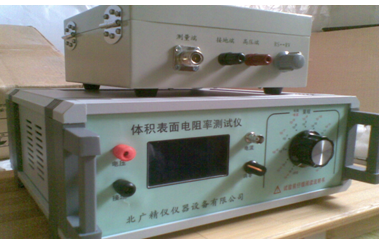
8體積電阻和表面電阻轉(zhuǎn)換
在測(cè)試過程中,使用屏蔽箱在進(jìn)行體積電阻和表面電阻轉(zhuǎn)換時(shí),必須把電源關(guān)閉后進(jìn)行檔位轉(zhuǎn)換,否則會(huì)導(dǎo)致電壓沖擊到主機(jī)無法顯示或損壞。
Usage
1. Connect the power cord properly
Ensure that the power supply is 220VAC/50Hz
2. Connect the power supply
Set the current resistance range to 104 and the voltage range to 10V, and then turn on the device.
3 Zero Adjustment
In the case of an open circuit at both ends of "Rx", zero the ammeter to display 0000 Attention: If there is no open circuit at both ends of "Rx", there will be significant errors in measurement after zeroing when connected to a resistance box or the object being measured. Generally, after one zeroing, there is no need to zero again during the testing process. Shut down after completion.
4 Connection lines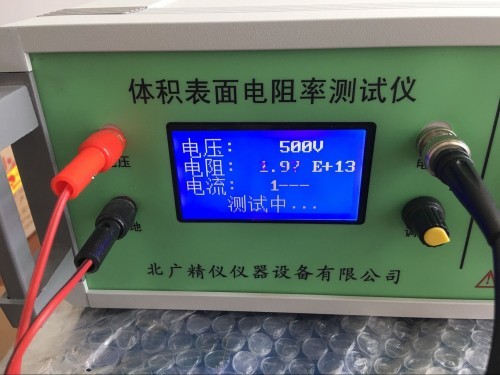
Connect the test line and connect the host to the shielding box. When measuring volume resistance, turn the test button to the Rv side, and when measuring surface resistance, turn the test button to the Rs side. Then turn on the device.
5. Choose the appropriate measurement voltage
The voltage selection switch is located on the back panel. Please note that the measured voltage should not be changed arbitrarily during the testing process, as it may damage the tested device or instrument due to excessive voltage or current;
6 Tests
When measuring, gradually shift from low gear to high gear, pause for 1-2 seconds each time to observe the displayed number. When the measured resistance is greater than the measuring range of the instrument, the resistance meter displays "1". At this time, continue to move the instrument to a higher range position. When the measuring instrument displays a value, stop. The current number multiplied by the level is the measured resistance value. When there are displayed numbers, do not dial higher gears, otherwise the measuring instrument will exceed the range, the internal protection circuit will start working, and the measurement accuracy of the instrument will decrease.
After completing the test, set the resistance current range to "104" and adjust the voltage range to 10V, then turn off the power
The range switch should be turned back to the range position of 104 "zero" for each measurement to avoid damaging the instrument in case of power on or short circuit at the measuring end. 6.8 Measurement of current and measurement of ultra-high resistance above 1015Ω. The method of calculating resistance by dividing voltage by current using Ohm's law after measuring current is detailed in section 8.5.
Conversion between Volume Resistance and Surface Resistance
During the testing process, when using a shielding box to convert volume resistance and surface resistance, the power must be turned off before gear conversion, otherwise it may cause voltage shock to the host and result in inability to display or damage.
表面電阻率surface resistivity
在絕緣材料的表面層里的直流電場(chǎng)強(qiáng)度與線電流密度之商,即單位面積內(nèi)的表面電阻。面積的大
小是不重要的。
注:表 面 電 阻 率 的S1單 位 是Q。實(shí) 際 上 有 時(shí) 也 用 “歐 每 平 方 單 位 ”來 表 示 。
技術(shù)指標(biāo)
1. 電阻測(cè)量范圍:1?104Ω ~1?1018Ω,分為十個(gè)量程。
2. 電流測(cè)量范圍為2?10-4A~1?10-16A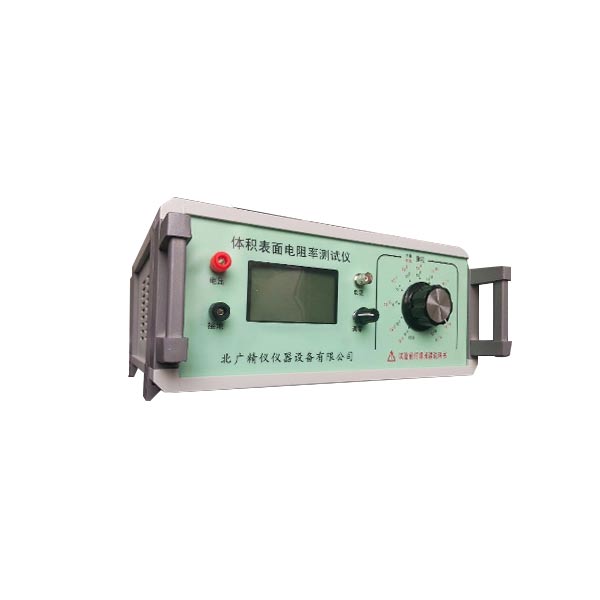
3. 全數(shù)字液晶屏顯示。
4. 準(zhǔn)確度:準(zhǔn)確度優(yōu)于下表
量程有效顯示范圍20~30℃RH<80%
104 0.01~19.99 5%
105 0.01~19.99 5%
106 0.01~19.99 5%
107 0.01~19.99 5%
108 0.01~19.99 5%
109 0.01~19.99 5%
1010 0.01~19.99 5% 2字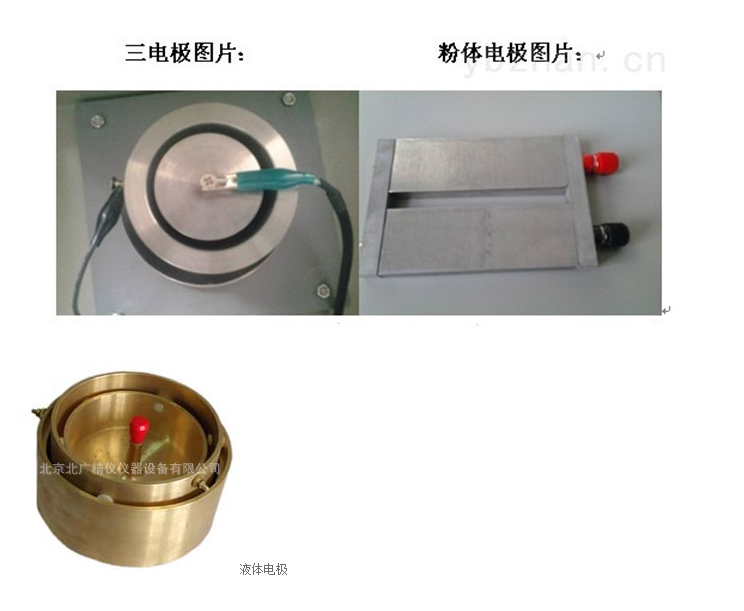
1011 0.01~19.99 5% 2字
1012 0.01~19.99 5% 5字
1013 0.01~19.99 10% 5字
1014 0.01~19.99 10% 5字
1014以上0.01~19.99 10-15% 5字
超出有效顯示范圍時(shí)誤差有可能增加,測(cè)試電流準(zhǔn)確度與電阻相同,測(cè)試電壓準(zhǔn)確度為10%
5.使用環(huán)境:溫度-10℃~50℃ 相對(duì)濕度<90%。
6.測(cè)試電壓: DC10V、50V、100V、250V、500V、1000V。?10%
7.供電形式: AC 220V,50HZ,功耗約10W。
8.儀器尺寸: 300mm?280mm?150 mm。
9.質(zhì)量:約3.0KG。
電極electrodes
電極是具有一定形狀、尺寸和結(jié)構(gòu)的與被測(cè)試樣相接觸的導(dǎo)體。
注:絕緣電阻是加在與試樣相接觸的兩電極之間的直流電壓與通過兩電極的總電流之商 絕緣電阻取決于試樣的表面電阻和體積電阻(見GB/T 10064-2006)
條件處理
試樣的處理?xiàng)l件取決于被試材料,這些條件應(yīng)在材料規(guī)范中規(guī)定。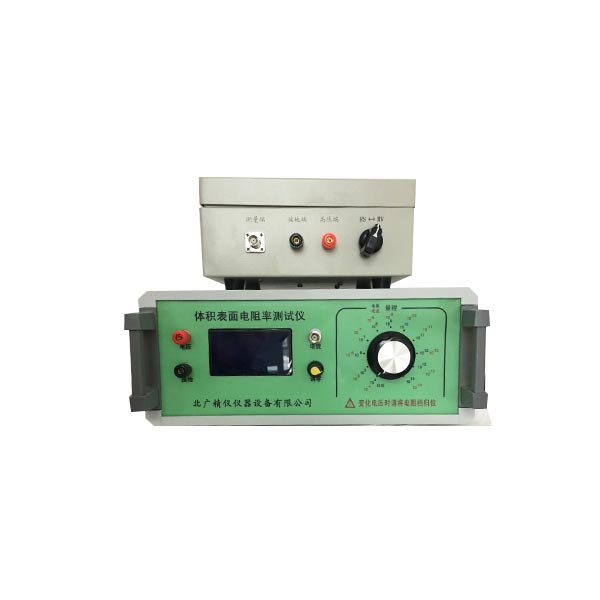
推薦按GB/T 10580一2003進(jìn)行條件處理;由各種鹽溶液所產(chǎn)生的相對(duì)溫度在IEC 60260中給出。
可以采用機(jī)械蒸發(fā)系統(tǒng)。
體積電阻率和表面電阻率都對(duì)溫度變化特別敏感。這種變化是指數(shù)式的。因此必須在規(guī)定的條件下來測(cè)量試樣的體積電阻和表面電阻。由于水分被吸收到電介質(zhì)內(nèi)是相對(duì)緩慢的過程,因此測(cè)定溫度對(duì)體積電阻率的影響需要延長處理期。吸收水分后通常會(huì)降低體積電阻。有些試樣可能需要處理數(shù)月才能達(dá)到平衡。
Volume resistivity
Before testing, the sample should be made to have a stable dielectric state. To this end, short-circuit the measuring electrodes 1 and 3 of the sample using a measuring device (Figure la), gradually increase the sensitivity of the current measuring device to meet the requirements, and observe the changes in the short-circuit current. Continue this process until the short-circuit current reaches a relatively constant value, which should be less than the stable value of the electrification current or less than the current for 100 minutes of electrification. Due to the possibility of the short-circuit current changing direction, even if the current is zero, the short-circuit state must be maintained for the required time. When the short-circuit current Io becomes essentially constant (which may take several hours), record the value and direction of Io.
Then add the specified DC voltage well and start timing at the same time. Unless otherwise specified, measurements shall be taken at each of the following electrification times: 1 minute, 2 minutes, 5 minutes, 10 minutes, 50 minutes, 100 minutes. If the same result is obtained from two consecutive measurements, the experiment can be terminated and this current value can be used to calculate the volume resistance. Record the electrification time when the same measurement result is observed. If a stable state cannot be reached within 100 minutes, record the functional relationship between volume resistance and electrification time.
As an acceptance test, according to relevant specifications, a fixed electrochemical time, such as the current value after 1 minute, is used to calculate the volume resistivity.
report
The report should include at least the following information:
a) Description and marking of materials (name, grade, color, manufacturer, etc.) for resistivity tester (resistivity tester);
b) The shape and size of the sample of the resistivity tester (resistivity tester);
c) The form, material, and size of electrodes and protective devices for resistivity testers (resistivity meters);
d) Processing of resistivity tester (resistivity tester) samples (cleaning, pre drying, processing time, humidity, and temperature), etc;
e) Test conditions for resistivity tester (resistivity tester) (sample temperature, relative humidity);
f) Measurement method of resistivity tester (resistivity measuring instrument);
g) Apply voltage to the resistivity tester;
h) Electrical resistivity tester (resistivity tester) body and resistivity (when needed);
Note 1: When a fixed electrification time is specified, indicate this time, provide individual values, and report the median as the volume resistivity.
Note 2: When testing after different electrification times, the following requirements should be reported:
When the sample reaches a stable state elbow within the same electrochemical time, provide individual values and report the median as the volume resistivity. If some samples cannot reach a stable state during this electrification time, report the number of samples that cannot reach a stable state and provide their results separately. When the test results depend on the electrification time, report the relationship between them, for example, in the form of a graph or provide the median volume resistivity after electrification for Imin, 10min, and 100min.
i) Surface resistivity (when needed):
Provide individual values with an electrochemical time of 1 minute and report the value as the surface resistivity.
測(cè)試步驟:
1、測(cè)試溫度23?2℃,相對(duì)濕度65?5%,無外界電磁場(chǎng)干擾環(huán)境中進(jìn)行。
2、測(cè)試時(shí)對(duì)試樣所加電壓為100V~500V的直流電壓,選擇電壓檔次。
3、將試樣倒入高壓電極內(nèi),使液面剛好和環(huán)電極下緣全部接觸為止。
4、將充分放電后的試樣和電極,按固體(液體)體積及表面電阻率測(cè)試儀要求接線。
外電極(高壓電極)接高固體(液體)體積及表面電阻率測(cè)試儀的高壓輸出端。
內(nèi)電極(測(cè)量電極)接固體(液體)體積及表面電阻率測(cè)試儀的測(cè)量端。
中電極(環(huán)電極)接固體(液體)體積及表面電阻率測(cè)試儀的接地端。
5、儀器預(yù)熱30分鐘,穩(wěn)定后調(diào)整儀器(調(diào)零),加上試驗(yàn)1分鐘,讀取電阻指示值,然后放電1分鐘,再測(cè)試一次,以二次的算術(shù)平均值作為試驗(yàn)樣品電阻指示值。
典型應(yīng)用
1.硫化橡膠體積、表面電阻率測(cè)定
2.測(cè)量防靜電鞋、導(dǎo)電鞋的電阻值
3.測(cè)量防靜電材料的電阻及電阻率
4.測(cè)量計(jì)算機(jī)房用活動(dòng)地板的系統(tǒng)電阻值
5.測(cè)量絕緣材料電阻(率)
6.光電二極管暗電流測(cè)量
7.物理,光學(xué)和材料研究
8.高分子材料表面體積電阻率測(cè)定
影響電阻率的外界因素
電阻率不僅與材料種類有關(guān),而且還與溫度、壓力和磁場(chǎng)等外界因素有關(guān)。金屬材料在溫度不高時(shí),ρ與溫度t(℃)的關(guān)系是ρt=ρ0(1 at),式中ρt與ρ0分別是t℃和0℃時(shí)的電阻率;α是電阻率的溫度系數(shù),與材料有關(guān)。錳銅的α約為1?10-1/℃(其數(shù)值極小),用其制成的電阻器的電阻值在常溫范圍下隨溫度變化極小,適合于作標(biāo)準(zhǔn)電阻。已知材料的ρ值隨溫度而變化的規(guī)律后,可制成電阻式溫度計(jì)來測(cè)量溫度。半導(dǎo)體材料的α一般是負(fù)值且有較大的量值。制成的電阻式溫度計(jì)具有較高的靈敏度。有些金屬(如Nb和Pb)或它們的化合物,當(dāng)溫度降到幾K或十幾K(絕對(duì)溫度)時(shí),ρ突然減少到接近零,出現(xiàn)超導(dǎo)現(xiàn)象,超導(dǎo)材料有廣泛的應(yīng)用前景。利用材料的ρ隨磁場(chǎng)或所受應(yīng)力而改變的性質(zhì),可制成磁敏電阻或電阻應(yīng)變片,分別被用來測(cè)量磁場(chǎng)或物體所受到的機(jī)械應(yīng)力,在工程上獲得廣泛應(yīng)用。
安全注意事項(xiàng)
1.使用前務(wù)必詳閱此說明書,并遵照指示步驟,依次操作。
2.請(qǐng)勿使用非原廠提供之附件,以免發(fā)生危險(xiǎn)。
3.進(jìn)行測(cè)試時(shí),本儀器測(cè)量端高壓輸出端上有直流高壓輸出,嚴(yán)禁人體接觸 ,以免觸電。
4.為避免測(cè)試棒本身絕緣泄漏造成誤差,接儀器測(cè)量端輸入的測(cè)試棒應(yīng)盡可 能懸空,不與外界物體相碰。
5.當(dāng)被測(cè)物絕緣電阻值高,且測(cè)量出現(xiàn)指針不穩(wěn)現(xiàn)象時(shí),可將儀器測(cè)量線屏 蔽端夾子接 上。 例如: 對(duì)電 纜測(cè)纜 芯與 纜殼的 絕緣 時(shí),除 將被 測(cè)物兩 端分 別接于 輸入 端與高壓 端, 再將電 纜殼 ,芯之 間的 內(nèi)層絕 緣物 接儀器 “G”,以消 除因 表面漏 電而 引起的測(cè) 量誤 差。也 可用 加屏蔽 盒的 方法, 即將 被測(cè)物 置于 金屬屏 蔽盒 內(nèi),接 上測(cè) 量線。
preparation:
1. Take 50ml of the tested liquid (such as plasticizer) sample.
2. The sample should be treated for more than 2 hours under the conditions of a temperature of 23?2℃and a relative humidity of 65?5%.
matters needing attention:
1. The measuring electrode must be placed on a highly insulated pad.
2. Before and after testing, the electrodes should be cleaned properly, especially the supporting parts of the three electrodes should not be contaminated by the sample
體積表面電阻率測(cè)試儀是一種用于測(cè)量材料絕緣性能的精密儀器,廣泛應(yīng)用于多個(gè)行業(yè),主要涉及對(duì)材料電絕緣性能有嚴(yán)格要求的領(lǐng)域。北京北廣精儀儀器設(shè)備有限公司聲場(chǎng)的體積表面電阻率測(cè)試儀主要用于以下主要適用行業(yè)及具體應(yīng)用場(chǎng)景:
1. 電子與半導(dǎo)體行業(yè)
應(yīng)用:測(cè)試PCB基板、絕緣薄膜、封裝材料、半導(dǎo)體晶圓等的電阻率,確保其絕緣性能滿足電子元件防短路、防漏電的要求。
案例:評(píng)估手機(jī)電路板在高濕度環(huán)境下的絕緣可靠性。
2. 電力與能源行業(yè)
應(yīng)用:檢測(cè)電纜絕緣層、變壓器油、復(fù)合絕緣子等材料的電阻率,保障高壓設(shè)備的安全運(yùn)行。
案例:高壓電纜出廠前的絕緣性能驗(yàn)證。
3. 航空航天與汽車制造
應(yīng)用:評(píng)估飛機(jī)復(fù)合材料、汽車線束、電池隔膜等材料的電絕緣性,防止靜電積聚或電磁干擾。
案例:新能源汽車電池組絕緣材料的質(zhì)量控制。
4. 科研與新材料開發(fā)
應(yīng)用:研究石墨烯、納米涂層等新型材料的導(dǎo)電/絕緣特性,優(yōu)化材料配方。
案例:柔性顯示技術(shù)中透明導(dǎo)電薄膜的研發(fā)測(cè)試。
5. 醫(yī)療設(shè)備與生物材料
應(yīng)用:檢測(cè)醫(yī)用塑料、導(dǎo)管、植入材料的絕緣性能,確保患者安全。
案例:心臟起搏器絕緣外殼的生物兼容性測(cè)試。
6. 塑料與橡膠工業(yè)
應(yīng)用:質(zhì)量控制環(huán)節(jié)中測(cè)量工程塑料、硅橡膠等材料的電阻率,用于防靜電包裝或絕緣部件生產(chǎn)。
案例:防靜電托盤用于芯片運(yùn)輸前的電阻率達(dá)標(biāo)測(cè)試。
6. 軍事與國防
應(yīng)用:評(píng)估隱身涂層、雷達(dá)吸波材料等的電學(xué)性能。
7 案例:軍用無人機(jī)復(fù)合材料的電磁屏蔽效能測(cè)試。
8. 建材與家居行業(yè)
應(yīng)用:檢測(cè)地板、墻板的防靜電性能(如數(shù)據(jù)中心地板)或絕緣性能(如電工套管)。
案例:潔凈室防靜電地板的驗(yàn)收測(cè)試。
9.能源存儲(chǔ)(電池與電容器)
應(yīng)用:測(cè)量隔膜、電解質(zhì)的電阻率,優(yōu)化鋰電池或超級(jí)電容器的性能。
案例:鋰電隔膜孔隙率對(duì)離子傳導(dǎo)性的影響研究。
10. 質(zhì)量控制與認(rèn)證機(jī)構(gòu)
應(yīng)用:作為第三方檢測(cè)工具,依據(jù)ISO/ASTM標(biāo)準(zhǔn)對(duì)材料進(jìn)行認(rèn)證(如UL認(rèn)證、RoHS合規(guī)性)。
案例:出口電子產(chǎn)品的絕緣安全認(rèn)證測(cè)試。
關(guān)鍵測(cè)試參數(shù)
體積電阻率(Ω?cm):反映材料內(nèi)部的絕緣性能。
表面電阻率(Ω/sq):評(píng)估材料表面的導(dǎo)電/防靜電特性。
行業(yè)標(biāo)準(zhǔn)參考
測(cè)試常遵循國際標(biāo)準(zhǔn)如IEC 60093、ASTM D257、GB/T 1410等,確保數(shù)據(jù)可比性。
總之,該儀器是材料電學(xué)性能評(píng)估的核心設(shè)備,覆蓋從基礎(chǔ)研究到工業(yè)生產(chǎn)的全鏈條需求,尤其在需要高可靠性絕緣或可控導(dǎo)電性的場(chǎng)景中不可或缺。
業(yè)務(wù)咨詢:932174181 媒體合作:2279387437 24小時(shí)服務(wù)熱線:15136468001 盤古機(jī)械網(wǎng) - 全面、科學(xué)的機(jī)械行業(yè)免費(fèi)發(fā)布信息網(wǎng)站 Copyright 2017 PGJXO.COM 豫ICP備12019803號(hào)